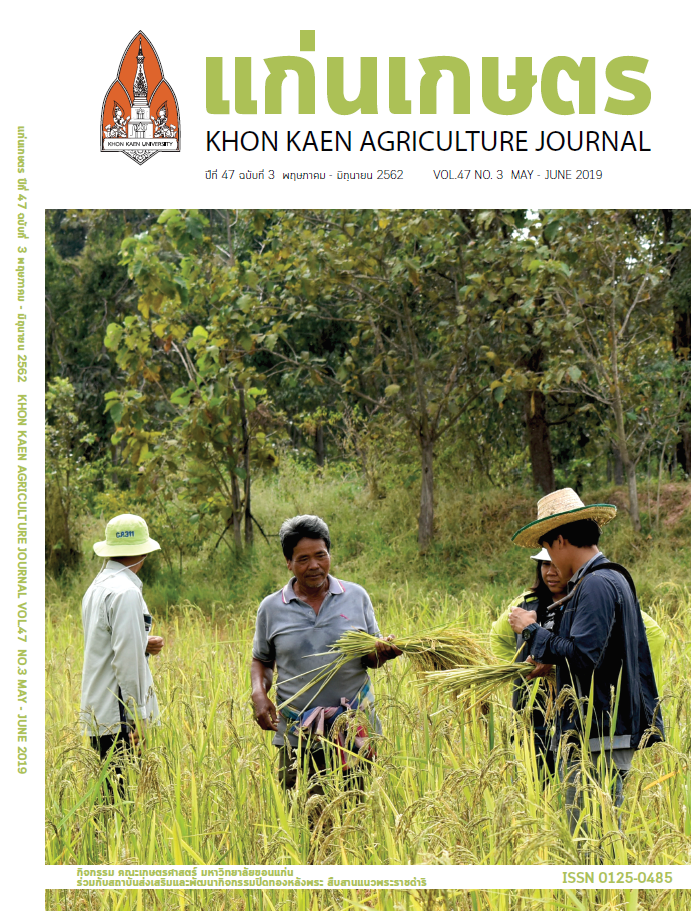ผลของสารสกัดจากพืชสมุนไพรบางชนิดต่อการควบคุมไส้เดือนฝอยรากปม Meloidogyne incognita (Kofoid and White, 1919) Chitwood, 1949
Main Article Content
บทคัดย่อ
การทดสอบ ประสิทธิภาพของสารสกัดจากพืชสมุนไพรที่สามารถยับยั้งการเจริญเติบโตของไส้เดือนฝอยรากปม ได้แก่ ดาวเรือง สะเดา และกระเทียม ในการควบคุมไส้เดือนฝอยรากปม Meloidogyne incognita (Kofoid and White, 1919) Chitwood, 1949 ในห้องปฏิบัติการ พบว่า สารสกัดกระเทียมทำให้มีพัฒนาการของไข่ช้าที่สุด สารสกัดทั้งสามชนิดที่สกัดด้วยน้ำสามารถลดการฟักไข่ของไส้เดือนฝอยได้ โดยที่อัตราความเข้มข้น 1:1 สามารถยับยั้งการฟักไข่ได้ดีที่สุด รองลงมา คือ สารสกัดกระเทียมที่อัตราความเข้มข้น 1:2 ส่วนสารสกัดกระเทียมที่อัตราความเข้มข้น 1:4 และสารสกัดที่อัตราความเข้มข้น 1:2 ของสารสกัดดาวเรือง และสารสกัดสะเดาสามารถยับยั้งการฟักไข่ได้ใกล้เคียงกันโดยไม่มีความต่างกันทางสถิติ ส่วนสารสกัดดาวเรืองที่อัตราความเข้มข้น 1:4 มีประสิทธิภาพในการยับยั้งการฟักไข่น้อยที่สุด ภายใต้กล้องจุลทรรศน์แบบสเตอริโอ พบว่า ในไข่ไส้เดือนฝอยที่แช่ในสารสกัดสะเดา และแช่ในสารสกัดดาวเรือง มีการพัฒนาเป็นตัวอ่อนระยะที่ 1 เมื่อเวลาผ่านไป 72 ชั่วโมงส่วนไข่ไส้เดือนฝอยที่แช่ในสารสกัดกระเทียมทำให้มีพัฒนาการของไข่ช้าที่สุด ส่วนการทดสอบในสภาพโรงเรือน พบว่า สารสกัดทุกชนิด ทุกอัตรา สามารถลดการเกิดรากปมได้ โดยที่สารสกัดกระเทียมมีประสิทธิภาพในการยับยั้งการเกิดปมได้ดีที่สุด รองลงมา สารสกัดสะเดา และสารสกัดดาวเรือง ให้ผลใกล้เคียงกัน
Article Details
เอกสารอ้างอิง
นุชนารถ ตั้งจิตสมคิด. 2540. รายงานวิจัยการป้องกันกำจัดไส้เดือนฝอยรากปมโดยไม่ใช้สารเคมี. กองโรคพืชและจุลชีววิทยา กรมวิชาการเกษตร, กรุงเทพฯ.
พรสุข ชัยสุข. 2558. ผลของสารสกัดจากดาวเรืองในการควบคุมไส้เดือนฝอยรากปมมะเขือเทศ. วารสารเกษตร. 31: 311-318.
สืบศักดิ์ สนธิรัตน. 2541. ไส้เดือนฝอยศัตรูพืช: โรคและการจัดการ. พิมพ์ครั้งที่ 1. สำนักพิมพ์รั้วเขียว, กรุงเทพฯ.
Agbenin, N. O., A. M. Emechebe, P. S. Marley, and A. D. Akpa. 2005. Evaluation of nematicidal action of some botanicals on Meloidogyne incognita in vivo and in vitro. Journal of Agriculture and Rural Development in the Tropics and Subtropics. 106: 29-39.
Alejandro, C., B. Vanholme, S. Vangestel, S. M. Kane, A. Bahaji, K. Pha, M. Garcia, A. Snider, and G. Gheysen. 2016. Early development of the root-knot nematode Meloidogyne incognita. Journal of
Biomed central developmental biology. 16: 10-23.
Dangal, N. K., D. Sharma-Poudyal, S. M. Shrestha, C. Adhikari, J. M. Duxbury, and J. G. Lauren. 2008. Evaluation of organic amendments against rice root-knot nematode at seedling stage of rice. Nepal Journal of Science and Technology. 9: 21-27.
El-Nagdi, W. M. A., M. M. A. Youssef, and M. G. Dawood. 2014. Efficacy of garlic clove and oil aqueous extracts against Meloidogyne incognita infecting eggplant. Pakistan Journal of Nematology. 32: 223-228.
Gommers, F. J. 1973. Nematicidal principles in c o m p o s i t a e . M e d e d e l i n g e n Landbouwhogeschool, Wageningen.
Hassan, M. A., P. S. Chindo, P. S. Marley, and M. D. Alegbejo. 2010. Management of root knot nematodes (Meloidogyne spp.) on tomato (Lycopersicon lycopersicum) using organic wastes in Zaria, Nigeria. Journal of Plant Protection Sciences. 46: 34-38.
Hartman, K. M., and J. N. Sasser. 1985. Identification of Meloidogyne species on the basis of differential host test and perineal pattern morphology. P. 69-76. In: K. R. Barker, C. C. Carter, and J. N. Sasser. An Advanced Treatise on Meloidogyne. Volume II: Methodology. North Carolina State University. Raleigh, North Carolina.
Hussey, R. S., and H. R. Boerma. 1981. A greenhouse screening procedure for root-knot nematode resistance in soybeans. Crop Sci. 21:794-796.
Kumar, S., and A. S. Khanna. 2006. Effect of neem-based products on the root-knot nematode, Meloidogyne incognita, and growth of tomato. Nematologia Mediterranea. 34: 141-146.
Marahatta, S. P., K. H. Wang, B. S. Sipes, and C. R. R. Hooks. 2012. Effects of Tagetes patula on active and inactive stages of root-knot nematodes. Journal of Nematology. 44: 26-30.
Taylor, A. L., and J. N. Sasser. 1978. Biology, identification and control of root-knot nematodes (Meloidogyne species). Department of Plant Pathology. North Carolina State University. Raleigh, North Carolina.


